
..........................................................................................................................................................................................................
this is cambridge omloop l/s jersey, l/s mesh baselayer, thermal bibshorts, kneewarmers and socks
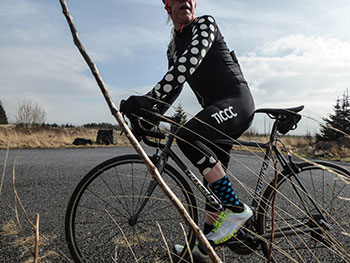
many a long year ago, a few colleagues and i travelled to scotland to participate in a team triathlon, an event in which three people each take on one discipline against others doing the same thing. due to the size of the swimming pool, the triathlon had to be run over an extended period of time, with only four swimmers in the pool at any one time. disappointingly, this meant that after a warm-up ride to recce the cycle course, i had to stand or sit for the next hour and a half until it was time to compete, rather negating the point of doing so in the first place.

in order to alert the swimmer that sufficient lengths had been completed, a red paddle board was dipped into the water, but unfortunately, the chap in my team failed to spot this and completed an extra two lengths. to add insult to injury, the bike ride time was started at the point when he ought to have finished, rather than the when he actually did so.
according to several notices posted around the transition area in which the bicycles were placed, there was to be no running in this section, a regulation which i dutifully observed. sadly, i appeared to be the only one, yet none of the others were penalised for skipping merrily towards the roadside. a mere matter of seconds after i had begun my ride, the heavens opened; before the first kilometre had been completed, there was water flowing out of my footwear.

we didn't win.
it is not, however, merely triathlons that have need of transition, as was demonstrated during yesterday's sunday ride. while my fellow peletoneers were clad in shorts and bare knees, i augmented my own pair of thermal bibshorts with a pair of kneewarmers, a feature that had pervaded during the previous week's riding. i cannot be rushed into the acceptance of sartorial folly.
daphne and andrew at this-is-cambridge, seem well attuned to this sense of dress, having sent me the excellently named long-sleeved, thermal omloop jersey, a garment which pushes the border between jersey and jacket, with neither emerging as specific victor. it is strikingly decorated in black and white, with the
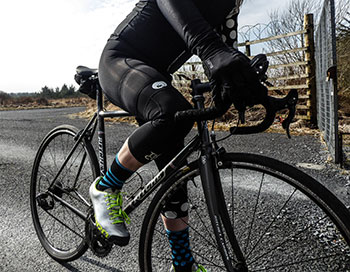 left sleeve sporting large white polka dots, which are not only large and white, but reflective into the bargain. the rightmost rear pocket is similarly decorated. i confess, i could live without the large emblazoned tic cc on the left breast, but since it had no power to slow me down, i figure i can put up with it. however, it is a nice touch to feature tic's motto of higher, further, faster on the lower section of the full-length zip cover.
left sleeve sporting large white polka dots, which are not only large and white, but reflective into the bargain. the rightmost rear pocket is similarly decorated. i confess, i could live without the large emblazoned tic cc on the left breast, but since it had no power to slow me down, i figure i can put up with it. however, it is a nice touch to feature tic's motto of higher, further, faster on the lower section of the full-length zip cover.
the unisex jacket has been coated with durable water repellency, making it at least showerproof in the face of adverse weather conditions. however, the obligatory three rear pockets offer more than sufficient space in which to carry a scrunched up waterproof jacket, should you intend to ride in less salutory conditions. oddly, while the length of the sleeves is nigh on perfect, i found the torso length just a
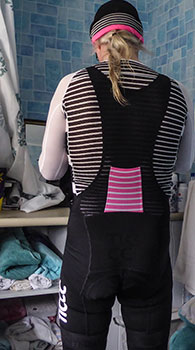 smidgeon too short. i'm sure this obviates any bunching in the sprint, but it did tend to leave an unfortunate gap where the thermal bibshorts worn below, reached their lowest point. to compound this slight misadventure, the mesh baselayer could really have done with being a couple of centimetres longer.
smidgeon too short. i'm sure this obviates any bunching in the sprint, but it did tend to leave an unfortunate gap where the thermal bibshorts worn below, reached their lowest point. to compound this slight misadventure, the mesh baselayer could really have done with being a couple of centimetres longer.
rather obviously, depending on your body's proportions, this might not affect you at all, but as one long of torso, perhaps i ought to have heeded this-is-cambridge's advice and sized up the way, though the rest of the jersey fitted just ginger peachy.
the bibshorts, aside from the observation made above, are quite superb. i admit that i've not tried them without the colour co-ordinated kneewarmers (should i have the polka dots on the same side as the sleeve, or go off-piste and pop them on the opposite leg?). currently, if you purchase the thermal bibs along wth the kneewarmers, you can save 20%; you'd be mad not to.
i have previously favourably reviewed a tic mesh baselayer and this black and white variation is no different. i would prefer a higher neckline in a baselayer designed for the colder weather, but, honestly, it hardly proved to be much of a problem when riding. the omloop socks, however, even without the aid of overshoes, were as cosy as a pair of really cosy things. i'm a great believer in wearing matching riding kit, even during my annual transition periods; i doubt there's a
 rule that says you can't match one brand with another, but baselayer, bibs, jersey, kneewarmers and socks all from the one source is a bit like owning an apple computer where hardware and software can be made to match. colour and quality in perfect harmony.
rule that says you can't match one brand with another, but baselayer, bibs, jersey, kneewarmers and socks all from the one source is a bit like owning an apple computer where hardware and software can be made to match. colour and quality in perfect harmony.
if i was guilty of designing my own cycle clothing, the motto emblazoned on the front would likely be cold, wet and windy, the very conditions in which i, several times, attempted to ride higher, further, faster clad in the finest omloopery. the lined jersey keeps both cold and wind in abeyance, while the comfort factor is beautifully handled by the bibshorts. the length of the jersey's sleeves was most impressive. the pad is easily amongst the finest on offer anywhere. no matter on which side i placed the white polka-dotted kneewarmer, they obviated any tendency towards easter knees as espoused by the late david duffield.

if the weekend's weather was anything to go by, the hebridean transitional period is likely to continue for a good while yet, before it all starts again in august (if only i was kidding).
the omloop long-sleeve thermal jersey is available in sizes ranging from xs to xl at a cost of £155. the thermal bibshorts can be purchased from xs to xxl only in black at a price of £175. the 3/4 length kneewarmers, if purchased alone, cost £50 per pair. sizing is xs to large. the long-sleeve baselayer is available with black or white hoops, in sizes xs to xxl and is priced at £44. the omloop winter socks, neither of which match each other apart from colour (black/blue, or black/pink) cost £19.50 in sizes 35-39, 40-43 and 44-47).
monday 16 april 2018
 ..........................................................................................................................................................................................................
..........................................................................................................................................................................................................nostalgic obsolescence

you'd think that, as an admittedly very small, niche market, velocipedinal technological development would exist more as background noise, rather than as a neon lit, exclamation mark. yet that hardly seems often to be the case. when the so-called cold war became essentially null and void, i found it remarkably surprising that those involved in the aerospace world looked to the bicycle to find new markets. titanium would probably never have become quite as popular as it once was, were it not for such circumstances; you'd have thought there were other markets more ripe for the picking.
in the current climate, when the bicycle has experienced a remarkable renaissance, this may appear something of a hard statement to justify. but cast your mind back to the late 1980s or early 1990s and i even recall the existence of a mountain bicycle fashioned from beryllium, a remarkably rare, steel-gray, yet strong, lightweight element. other than high cost (if i remember correctly, at the time, the beryllium frame could be had for £24,000), its only temperamental downside was that of brittleness. i'm pretty sure its brief existence was that of a design exercise, rather than the considered future of offroading.
nowadays, carbon frames are mostly constructed as monocoques, where the pre-impregnated resin/carbon matting is placed inside expensive molds and baked until the flavour is just what the average roadie expects from the shop floor. tubing, if that remains an appropriate description, is no longer round in shape, either because the wind tunnel says it no longer needs to be, or because the designer has learned the flexibility of bezier points in his/her cad/cam software and gone wild.
the list of component parts that scarcely look like their ancestors is legion: threadless headsets, now integrated inside considerably enlarged head tubes, bottom brackets that have escaped the threaded shells that used to contain them, ultimately losing the threads entirely and being press-fitted into the colossally over-sized carbon shells. stems now feature removeable faceplates, seatposts are held in place by small, frame inserted wedges; brakes now feature dual pivots, frame pivots or hydraulic discs, the latter having caused those frame designers to reconsider where the tough bits of the forks now have to be.
much of this has been at the behest of the great god stiffness, a buzzword that seems to have been accepted every bit as much by leisure velocipedinists as by those involved in the more competitive realms. in my opinion, it's comparable with single malt whisky aficionados readily believing that their drams are matured in oak casks, ensconced in stone warehouses, sited adjacent to atlantic waves. (most of it is tankered to pre-fab warehouses in central scotland).
but, as with many developments, there are upsides and downsides. for luddites such as myself, there was nothing wrong with five-speed freewheels, lugged steel frames with quill-stems and cup & cone, square-taper bottom brackets. but as a minority of one, i was never likely to add to the profit margins of the bicycle industry, who could probably care less that i have boxes full of tools that are now all but obsolete...
...or lost.
fortunately, many of these obscure bicycle tools are still available if you go looking (though many, too many were out of stock). in order to fit a brand new, shiny, campagnolo eleven-speed groupset to a carbon colnago, i first had need of removing the ageing ten-speed agglomeration that has been its mainstay for more years than i'd care to admit. it was disappointing to discover that the crank bolts were not of the self-extracting variety, even more so on discovering that my crank extractor was not in the toolbox where it ought to have been.
the ordered item having arrived sooner, rather than later and the cranks no longer on the bicycle, you can perhaps imagine just what level of distraught i experienced, on realising that the last time i'd seen my campagnolo cartridge bottom bracket remover, peter sagan was still in short trousers. once again, those web pages have been trawled to find the relevant device actually in stock. it's perhaps quite humorous to contrast the the rapid pace of technological development currently apparent in the bicycle industry, with the snail's pace prevalent in one man's endeavours to remove yesterday's technology.
you may well laugh, but the jury's out on how many years will pass, before the tools presently occupying the nether regions of your bike shed, will also have gone the way of the dodo.
cotter pins, anyone?
sunday 15 april 2018
 ..........................................................................................................................................................................................................
..........................................................................................................................................................................................................ale and hearty

these days, the water bottle on my bicycle - the road bike; a true cyclocrosser would never augment knobblies with drink - contains solely h2o. and despite constant badgering from my work colleagues about the need to drink more, that bottle usually still features the same quantity of water on arriving home, as it had when i left. the mighty dave t has oft related that, in his day, the prevalent thinking was that there was little or no need to drink on any ride of less than 60 miles. contemporary nutritional advice would turn pale white at the thought of such intentional dessication. having said that, i read, not so very long ago, that there was no requirement to constantly sip from the bottle: that's what thirst is for.
it seems that my metabolism is very much in favour of the latter.
yet the apparent inability to grab a swift gulp in the heat of battle can prove at least mildly irritating. on the campagnolo bicycle loaned to me by velotech for last year's london-paris. there was a carbon campagnolo record bottle cage affixed to the down tube. and though it grasped tight hold of my water bottle, it seemed remarkably reluctant to let go when an unquenched thirst struck mid-ride. given my relatively isolated residence, i have little experience of riding in close proximity to others at speed. you can, therefore, perhaps identify with my reluctance to attempt not only removing the bottle from its cage, but with the potential struggle trying to put it back.
necessity eventually proved to be the mother of inevitablity; yours truly survived to write another day.
but water, though 'tis now my tipple of choice (san pellegrino during velocipedinal down time), was not always first on the list during those early days on the outer edge, unencumbered as i was by any velocipedinal knowledge whatsoever. word on the street was that those expended calories required to be replaced sooner, rather than later and preferably in liquid form to ease the problems of digestion while energy expenditure was at its highest. what i had failed to take note of was the rather minimal distances i liked to call training in those days, distances that scarcely demanded a slurp of water, let alone a flavoured carbo drink.
distances with rapha travel in provence were demonstrably longer, occasionally with kilometres measured in hundreds. slurping mid-ride was pretty much a necessity, but on returning home each day, ready and waiting under the rapha gazebo was a number of bottles filled with a recovery protein drink. though ingestion was probably recommended, its taste suggested otherwise. so, after reviewing a wide range of energy drinks over the years, i have settled on water, though as previously mentioned, it is carried rather than consumed.
it would seem, therefore, that the cyclist's drinks cabinet begins with water and probably ends with a mix of carbohydrates and protein tasting of lemon and lime. but, if the folks at fat lad at the back and wharfdale brewery are to be taken account of, there will need to be another shelf above that one, expressly designed to accommodate bottles of 'a straw coloured blonde session ale combining English malts with a blend of New Zealand and American hops to create a lingering citrus grapefruit flavour and a fresh satisfying bitter finish.'
i know i could not have put it better myself.
king o't' mountains has been brewed to celebrate this year's tour of yorkshire (3 - 6 may) and will be available in the brewery's flagship pub, the flying duck. as well as one or two other hostelries throughout yorkshire's wharf valley. i should stress that this ale definitely falls into the class of post ride refreshment; i seriously doubt that the boys in blue would give a second thought to detaining any rider found to be inebriated in charge of a bicycle. therefore, it is wise to drink responsibly.
fat lad at the back | wharfdale brewery
saturday 14 april 2018
 ..........................................................................................................................................................................................................
..........................................................................................................................................................................................................pie and sky
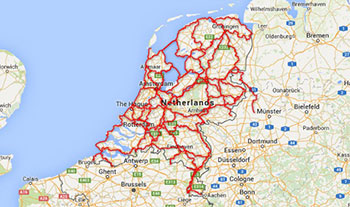
the phrase 'build it, and they will come' has frequently be used to persuade national and local government that building cycle paths would almost certainly result in increased numbers deserting their cars fin favour of two wheels. though ostensibly a logical proposition, on closer examination, things don't always work out according to the best laid of plans. carlton reid's recently published book 'bike boom' makes it markedly clear that the town of stevenage, purposely designed to segregate motorised and cycle traffic, offered "...a shining example of how the provision of high-quality, joined-up cycle infrastructure (that) would encourage many to cycle, not just keen cyclists."
yet despite the best of intentions on behalf of planner eric claxton and very much to his puzzlement "...residents of Stevenage chose to drive, not cycle, even for journeys of two miles or less." sadly, knowledge of this salient fact is oft quoted by town planners eager to salve more from their roads budget than would otherwise be the case.

in the 1940s and early fifties, before the motor car became the transport of choice, britain was in thrall to the bicycle, using it to get to and from work, school, the shops and congregating in large pelotons at the weekend for trips to the country. in those mid-century days, it was mostly the aristocracy and well-heeled who owned motor cars, who traversed the restricted road infrastructure, the expansion of which ultimately fostered britain's exponential growth in car use. it's worth remembering that britain's first motorway, the m1, wasn't opened until november 1959. there are now around fifty motorways in the uk, totalling over 3,500 kilometres (excluding northern ireland), to say nothing of the lesser designated tributaries that criss-cross the majority of the country.
the cost of building one kilometre of motorway seems to vary quite a bit; glasgow's m74 extension, opened in 2011 (for example), cost the taxpayer around £86 million per kilometre, while one kilometre of cycle path (again, the cost varies depending on circumstances) is around £50,000. i wholeheartedly agree that comparing the above two figures is a bit like matching apples with tractors, but nonetheless, the difference is, if nothing else, highly illustrative.
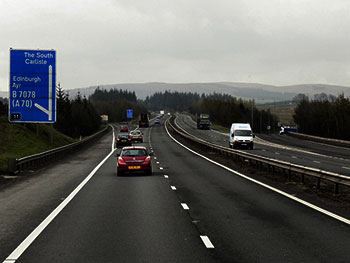
by law, motorways are not accessible to those of us on bicycles, though i can think of few who would want to ride them in the first place. nor, indeed, would we be overly happy riding many of the a class roads, due to the colossal numbers of motor vehicles clogging each lane. yet a recent article in the guardian newspaper predicted that, assuming all remains as it is, by the mid 2020s, the speed of motor vehicles in london will have dropped lower than the 12mph average speed of an adult cyclist. if ever there was justification for a rethink, if not of the motorway system, at least of inner city transport, that is surely it?
but those figures refer solely to the uk; not to suggest that costs are any lower in mainland europe, but, as if we didn't already know, certain of those european countries have an altogether different approach to the bicycle as a pragmatic means of commuting transport than does the government of the united kingdom. surely the definitive example of this is the proposal to build 1.7 kilometres of cycle route between the east netherlands towns of wageningen and arnhem. not content with so doing to reduce the commute time between those two cities, in order that they remain open for business all year round, the pathway will be kept warm by means of residual heat from a nearby paper plant.
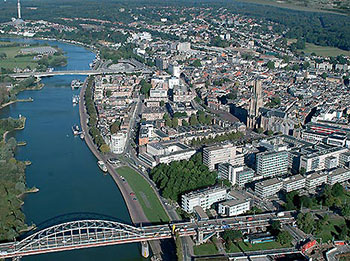
yes, really.
and apparently the sole concern over dutch cycling's electric blanket, is the possibility that local frogs might find the extra heat an attractive excuse to laze about on the tarmac. gelderland council, responsible for engineering a snow and frost free route for the benefit of pedallists, has promised to monitor any adverse effect on local wildlife, including those frogs. "The path is mainly for commuters," said petra borsboom, a council spokeswoman. "We don't want to use salt to keep it snow-free."
would anyone care to wager how soon britain might follow suit?
friday 13 april 2018
 ..........................................................................................................................................................................................................
..........................................................................................................................................................................................................does any of this really make any sense?

"I did have to kinda boss the credentials lady. She was like 'You're not on there', and I was like, 'I'm on there' and she was like 'You're not on there' and I was like 'I'm on there' and she was like 'You're on there' and I was like 'I know!'
cycle racing is, along with the majority of contemporary sports, what might easily be described as an organised sport. if evidence were required as to the veracity of that statement, you need only take note of the annual reveal of the following year's tour de france route. photos from just such an event often portraying our heroes dressed in smart suits or formal clothes, several stages removed from team kit or sponsors' track suits. on race day, the phalanx of accompanying vehicles will have need of the appropriate accreditation, route maps, hotel information, while the mechanics will need to know just where to park their well-equipped trucks.

fans, journalists and photographers will need to be aware of the parcours, all the better to choose their vantage points throughout each succeeding day, even though months of planning will result only in a brief flash of colour before it's time to think about next year, or how quickly to move on to vantage point n + 1.
those who have read will fotheringham's book, sunday in hell, will have learned of the strategies and complexities of organising more than two dozen cameramen, to eventually produce one of the iconic movies of the century. modern-day television coverage needs to be scheduled to the last minute, taking into account one or two helicopter mounted aerial cameras, providing even the accidental fan with superlative access to, hopefully, fervent bike racing. it is, to place not too fine a point on it, the acceptable face of competitive cycling.
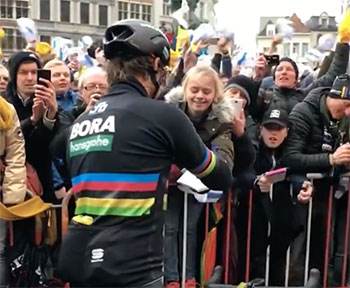
but in the process of creating all this organisation, what if something has been missed? nobody would deny that watching live television coverage is bound to result in far better joined up thinking than standing at the roadside squinting through billowing lion of flanders flags, past a wide range of differing heads and shoulders, all contriving to obscure a clear view of proceedings. but the very act of being there is frequently justified by experiencing the undefinable, ambient atmosphere, a factor that, could it be successfully bottled, would undoubtedly result in substantial profits for the bottler.

all the foregoing, however, takes no account of the inimitable manual for speed; not, as it turns out, a spanish ballad crooner, but once again daniel wakefield pasley and his intrepid, if a tad obscure entourage, velocipedinal investigators at large. they have, for 2018, decided to minimise their activities in favour of a sole (soul?) objective. in their own words: "This year here's the deal. We're going to focus on one project. Everything else, every other aspect of MFS [except basic race reports], is cancelled. That one project is called Dear Cycling, We're Fans."
their enthusiasm is hard to fault, even if their interview technique is.

the first instalment of this new mindset originated at the ronde van vlaanderen, where the race organisers committed the cardinal sin of providing mfs with race accreditation; cards and lanyards that have resulted in what can only be described as an idiosyncratic view of the race. eccentric might well be a more appropriate adjective. yes, it is undeniably an american view of european bike racing, but if you find this youtube video just a touch on the scary side, i should warn you that the mfs crew also attended paris-roubaix, coming to a web browser or youtube app near you, probably sooner than you'd like to hope.
if you've been affected by any of the events described above, please call the 24 hour manual for speed hotline.
thursday 12 april 2018
 ..........................................................................................................................................................................................................
..........................................................................................................................................................................................................picture perfect
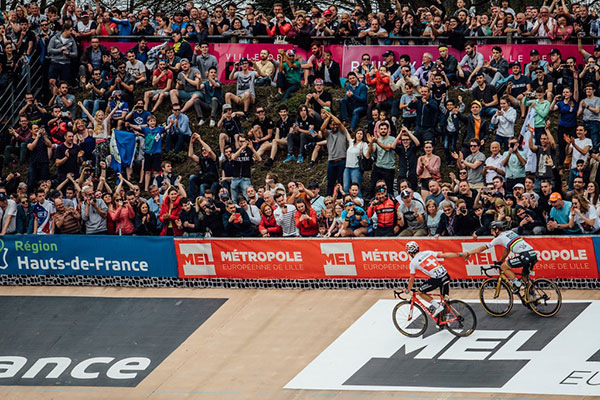
the long-lived philosophical query "if a tree falls in the forest and there was nobody there to see/hear it, did it actually fall?", is one that likely equates with "what is the sound of one hand clapping?" quite possibly on the grounds that there is no 'correct' answer to either. one or t'other could be easily compared to the reportage of cyclesport in the years before wall to wall television coverage, when, we are readily advised, journalists covering each event could be more than just creative with the truth.
in the absence of minute by minute recorded footage and a phalanx of spectators with iphones and ipads, it would have been very difficult to disparage any first hand accounts, allegedly witnessed by those whose job it was to interest the public in the vagaries of cycle racing. bear in mind that, as with several of many of the recent classics, many events were sponsored by newspapers and it was ultimately the job of those reporting to help sell more copies, by absorbing their reading public in the twists and turns of velocipedinal intrigue.
nowadays, it would be hard for anyone to recite a fictional account of any professional race you care to mention. aside from increased coverage from the home of cycling (eurosport), it would not be the first time i have claimed that cycle racing must be amongst the most photographed of all sports and to benefit from the lenses of some of the world's finest photographers. television coverage of this year's ronde van vlaanderen began at the unheard of hour of 09:30 on a sunday morning, while that of last weekend's paris-roubaix was but thirty minutes shy of the latter.
in addition to the above, should you be a subscriber to eurosport player, there is the opportunity to access their on demand service, one which can be paused or repeated ad finitum, should one particular manoeuvre have grabbed your attention. of course, all this is augmented by immediate replays of those we may not have seen clearly (quite often crashes). eurosport's paris-roubaix coverage featured ultra slow-motion replays showing just how hard those chains work at remaining connected to the chainrings.
while televisions are now capable of displaying so-called 4k resolution, one step up from the previously promoted high-definition, it's hard to argue against the quality of today's digital stills cameras, particularly when in the hands of an expert photographer. many of the latter are so well acquainted with the ins and outs of the beautiful sport, that they often seem to anticipate certain outcomes and snap them just as they happen.
many years ago, when improvements were being carried out at bruichladdich pier, i was reviewing a handlebar mounted device that allowed the rider to direct the camera toward images that had less need of relying purely on the scene directly in front. as i passed the pier, the contractors detonated an underwater explosion, the results of which i managed to accidentally capture in pixels. the difference being that there's no chance on this earth that i could have deliberately managed to do so.
that, to be quite blunt, is the major difference between a professional such as chris auld and a rank amateur such as yours truly.
in the seconds after peter sagan became the first rider since bernard hinault in 1981, to win paris-roubaix while wearing the rainbow jersey, chris was able to capture the moment as sagan proffered a handshake to swiss champion and second place finisher, silvan dillier. it was one of those moments when we, as cycle racing aficionados, could be unbearably smug in the face of bemused innocent onlookers. but telling the latter of that which we had just witnessed would surely be undermined without some physical manifestation of its occurrence.
as the saying goes, "if it's not on instagram, it didn't happen", a situation that can now be upgraded to your sitting room wall via the band of climbers link posted below. dillier described sagan as both an angel and the devil; if it hadn't been for the czech, dillier would never have reached the velodrome in the first two. but had it been with anyone other than sagan, the swiss felt he may have had an evens chance of victory.
printed on white, 308gsm hahnemuhle photo rag, the inkjet print meets the highest industry standards, perfect for framing and subsequently hanging above the fireplace. though the captured scene is quite literally priceless, band of climbers are willing to settle for a mere £55 plus postage.
and that's anything but cobbles.
admiration in roubaix velodrome
wednesday 11 april 2018
 ..........................................................................................................................................................................................................
..........................................................................................................................................................................................................language, timothy

in the light of my continuing interest in the mores and joys of continental cycling, both leisure and sporting, the ability to speak a language other than english would surely have been a distinct advantage. in the early years of secondary school i recall displaying a reasonable affinity with french, but due to the complexities of the educational timetabling system, i found myself attending statistics classes for at least half of the time that my classmates were 'parleying vous francais'.
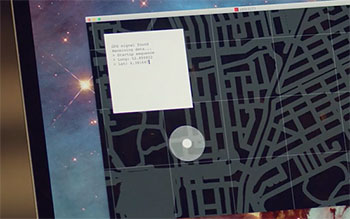
thus, french had to be discounted entirely, but you will be pleased to learn that i am in possession of an o-level certificate in statistics. i did make a valiant attempt to undertake french in evening classes, but by that time, english was no longer taught in terms of adjectives, past participles and adverbial clauses, making it all but impossible (for me) to make an appropriate connection.
since those days, i have remained frenchless, though i can convincingly and correctly, pronounce bernard hinault.
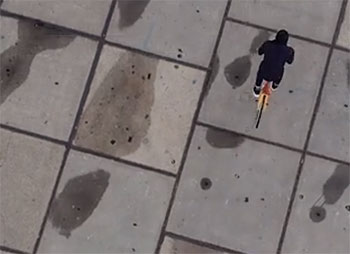
moving west to the hebrides over thirty years ago, brought to mind the social niceties of attempting to fit in, purchasing a cassette tape (remember those?) accompanied book featuring lessons in gaelic. to place all in some sort of context, that was several levels of horror worse than french. unlike the latter, gaelic words are not pronounced anything like the way they are spelled and the phonetic assistance along with each phrase was of little help. after weeks of partial study, it's of little help to learn that there are, in fact, several different flavours of gaelic, each reluctant to acknowledge the portended ubiquity of the other. little approbation is to be gained from learning lewis gaelic, when living on one of the more southern islands.
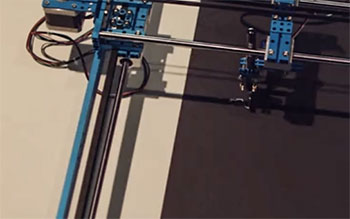
to make matters worse, it transpires that, due to a particularly retrograde step taken by scotland's educational authority many moons ago, very few of the island's gaelic speaking population owned the ability to read it.
however, i have always shown a slight flair when using the english language, one that i have made heavy use of when scribbling these daily musings on the velocipedinal world. though slightly modified over the years, my original rule du jour, had been to employ the words less travelled, if you'll pardon the phrasing. if there were shiny words rarely used, i made it my mission to use them where appropriate. so doing has led to many an e-mail from my reader bemoaning the need to purchase a more comprehensive dictionary.
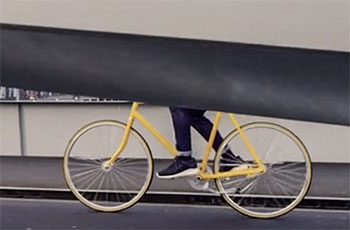
along with the intentional lack of capital letters, think of it as a feature, not a bug.
however, i have mostly stopped short of incorporating swear words in these black and yellow monologues, not purely for reasons of prudishness, but more logically on the basis that there are usually more appropriate words or phrases available. philippa york once stated that joining the professional peloton, midst its cosmopolitan make-up, if nothing else, provided a rapid education in the ability to swear in several different languages.
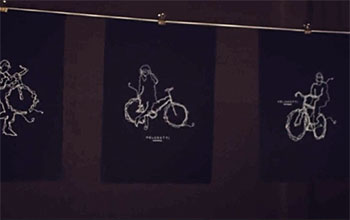
sadly, this carefully curated avoidance of the curse, scarcely extends to the spoken word, particularly with the onset of the easter holidays, when the island's roads seem crowded with audis, bmws and range rovers. lest you think me inexplicably elitist, few of the drivers of such vehicles seem even remotely aware of the legal speed limits. nor indeed, do they seem to have noticed the dotted white lines down the centre of our roads, nor that blind corners offer no advance warning of oncoming vehicles, when overtaking the lone cyclist.
in situations such as the above, i have been heard to issue a resounding "i say chaps, that's a tad inconsiderate." i'm also inclined to heartily agree with the message creatively revealed at the end of the short film linked below.
the future belongs to bikes.
veloretti movie | veloretti.com
tuesday 10 april 2018
 ..........................................................................................................................................................................................................
..........................................................................................................................................................................................................